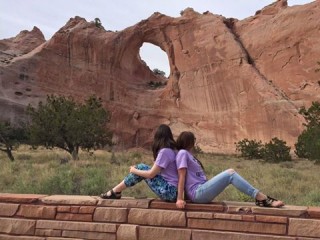Title

We had no idea how much the workshop we offered would mean to us in every regard.
This article is one of several about the 2016 Summer Engagement Grant recipients.
Body
Place The Navajo Nation, New Mexico
Summer Engagement Grant Project The Heartbeat Project—combining music and math education for Navajo children
Participants Fourth-year violinist Ariel Horowitz (Stephen Ian Handleman, Arnold R. Deutsch/Dorothy DeLay, and James C. Caple scholarships) and second-year violinist Leerone Hakami
We had no idea how much the workshop we facilitated would mean to us in every regard: artistically, pedagogically, and as human beings. We were challenged, our horizons broadened, and our perspectives shifted. We came away filled with gratitude and excitement to pursue an even greater iteration next summer.
Our process officially began with the thrilling receipt of a Juilliard Community Engagement Grant last winter. Ariel's mother and aunt, both of whom are actively involved with cultural exchange and activism on the Navajo Reservation, had told her that there was a desire for a children's music and math summer program through Navajo Technical University. I joined her on what we came to call the Heartbeat Project, and we couldn't have made a better team for this adventure.
Our first challenges were inventing a curriculum, obtaining instruments, and arranging lodging and meals with our hosts at the university, but the greatest challenge—and joy—ended up being the cultural exchange. While both of us have had previous experiences with community engagement, neither of us had much knowledge about Navajo culture and customs, and we quickly discovered how different this community is from our own. There has been a tragic history of outsiders entering native space and disrespecting traditional customs, with the belief that Western American ways are “superior.” On the opposite side of the spectrum, native people have repeatedly been the victims of Western voyeurism, and these people's intrinsic humanity removed when their culture is placed on a pedestal.
We wanted to offer our skills, time, and culture to the Navajo community while staying open and mindful to learning from and advocating for the people themselves, so we strove to create a workshop in which we were students just as much as teachers. Upon our arrival, our host, Wesley K. Thomas, the university's dean, informed us that the Navajo people's preferred term of self-identification is Diné, which identifies them as the children of Mother Earth and Father Sky. The Diné people serve as the protectors of these sacred entities and are in turn granted protection by the four sacred mountains surrounding their land. We had the rare and humbling honor of being invited into the sacred hooghan, the Diné people's traditional space of both home and worship, and even allowed to use that space for our workshop!
We worked with seven students, ages 7 to 16, during our week on the reservation. They had little to no musical background, yet they were deeply invested in learning and in this experience. Each morning we sat around the unlit fire pit of the hooghan surrounded by music, instruments, and laughter for two hours, and by the end of our time together, each student was able to perform “Hot Cross Buns” on recorder and xylophone and, using mathematical skills, understand the concepts of rhythm, pitch, and basic musical notation. But for us an even greater gift than those accomplishments was seeing the passion, dedication, and confidence that we helped them find within themselves. Seeing the smiles spread across the faces of their proud family members who watched them perform at the end left us speechless.
The Navajo Nation has some of the most extreme poverty, hunger, and illiteracy rates in the U.S., the responsibility for which lies in the hands of the American government and people. Opportunities for young Diné children to truly feel good about themselves are few and far between. But in that space of suffering is also a place of hope, community, beauty, and humanity, which are qualities we can all learn from. We feel so lucky to have had this opportunity to learn and grow alongside our students.





